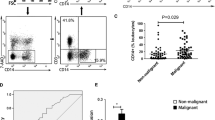Abstract
Macrophages are among the infiltrate components of most malignant tumors. Tumor-associated macrophages (TAMs) may secrete a variety of humoral factors, which promote or inhibit tumor growth. In general, depending on their activation pathway, macrophages exhibit two different patterns of phenotype, M1 or M2. It is assumed that TAMs comprise pattern M2. In the malignant pleural effusion, macrophages are a frequent component of cytological evaluation. In this microenvironment, TAMs could be involved in the development of immunity. The phenotype of macrophages represented in malignant and non-malignant pleural effusions is unknown. In this study, macrophages were isolated from 38 pleural effusions (15 malignant and 23 non-malignant) and the expression of a variety of immune mediators and their receptors was assessed to determine the type of activation (M1 vs. M2). The expression of mRNA was analyzed for IL-1β, IL-4, IL-6, IL-10, IL-11, IL-18, TNFα, TGFβ1, IL1R1, IL1RAP, TLR2, TLR4, VLA4, CD62L, MMP2, MMP9, VEGFA, PDGFA, and PDGFB. In immunohistochemical evaluation, the expressions of CD68, mesothelin, MAC387, IL-1β, IL-6, IL-10, IL-12, TNFα, and CD105 were assessed. The cytoplasmic expression of IFNγ, TNFα, IL-6, and IL-10 and the surface expression of CD11a, CD14, CD15, CD16, CD23, CD25, CD45, CD54, CD62L, CD69, VLA2, VLA3, VLA4, VLA6, TLR2, TLR4, and CCR7 were tested using flow cytometry. In supernatants from macrophages cultures, TNFα, IL-1β, IL-6, IL-8, IL-10, IL-12, MCP1, and VEGF were investigated by cytometric beads array method (CBA flex sets) and TGFβ1 by ELISA. Our results indicate that macrophages from malignant and non-malignant pleural effusions differ from each other and suggest that macrophages isolated from non-malignant effusions show a pattern comparable to M1 while those isolated from malignant effusions express similarity to M2 phenotype, but they have not shown a classical M2 pattern.


Similar content being viewed by others
References
Gjomarkaj M, Pace E, Melis M, Spatafora M, Toews GB. Mononuclear cells in exudative malignant pleural effusions. Characterization of pleural phagocytic cells. Chest. 1994;106:1042–9.
Frankenberger M, Passlick B, Hofer T, Siebeck M, Maier KL, Ziegler-Heitbrock LH. Immunologic characterization of normal human pleural macrophages. Am J Respir Cell Mol Biol. 2000;23:419–26.
Park JS, Kim YS, Jee YK, Myong NH, Lee KY. Interleukin-8 production in tuberculous pleurisy: role of mesothelial cells stimulated by cytokine network involving tumour necrosis factor-alpha and interleukin-1 beta. Scand J Immunol. 2003;57:463–9.
Martinez FO, Sica A, Mantovani A, Locati M. Macrophage activation and polarization. Front Biosci. 2008;13:453–61.
Mosser DM. The many faces of macrophage activation. J Leukoc Biol. 2003;73:209–12.
Mukhopadhyay S, Chen Y, Sankala M, Peiser L, Pikkarainen T, Kraal G, et al. MARCO, an innate activation marker of macrophages, is a class A scavenger receptor for Neisseria meningitidis. Eur J Immunol. 2006;36:940–9.
Gordon S, Taylor PR. Monocyte and macrophage heterogeneity. Nat Rev Immunol. 2005;5:953–64.
Mantovani A, Bottazzi B, Colotta F, Sozzani S, Ruco L. The origin and function of tumor-associated macrophages. Immunol Today. 1992;13:265–70.
Ono M, Torisu H, Fukushi J, Nishie A, Kuwano M. Biological implications of macrophage infiltration in human tumor angiogenesis. Canc Chemother Pharmacol. 1999;43(Suppl):S69–71.
Bingle L, Brown NJ, Lewis CE. The role of tumour-associated macrophages in tumour progression: implications for new anticancer therapies. J Pathol. 2002;196:254–65.
Torisu H, Ono M, Kiryu H, Furue M, Ohmoto Y, Nakayama J, et al. Macrophage infiltration correlates with tumor stage and angiogenesis in human malignant melanoma: possible involvement of TNFalpha and IL-1alpha. Int J Canc. 2000;85:182–8.
Biswas SK, Sica A, Lewis CE. Plasticity of macrophage function during tumor progression: regulation by distinct molecular mechanisms. J Immunol. 2008;180:2011–7.
Kaczmarek M, Frydrychowicz M, Nowicka A, Kozlowska M, Batura-Gabryel H, Sikora J, et al. Influence of pleural macrophages on proliferative activity and apoptosis regulating proteins of malignant cells. J Physiol Pharmacol. 2008;59 Suppl 6:321–30.
Noonan DM, De Lerma Barbaro A, Vannini N, Mortara L, Albini A. Inflammation, inflammatory cells and angiogenesis: decisions and indecisions. Canc Metastasis Rev. 2008;27:31–40.
Mantovani A, Sica A, Sozzani S, Allavena P, Vecchi A, Locati M. The chemokine system in diverse forms of macrophage activation and polarization. Trends Immunol. 2004;25:677–86.
Atanackovic D, Cao Y, Kim JW, Brandl S, Thom I, Faltz C, et al. The local cytokine and chemokine milieu within malignant effusions. Tumour Biol. 2008;29:93–104.
Förster R, Davalos-Misslitz AC, Rot A. CCR7 and its ligands: balancing immunity and tolerance. Nat Rev Immunol. 2008;8:362–71.
Fenton KN, Richardson JD. Diagnosis and management of malignant pleural effusions. Am J Surg. 1995;170:69–74.
Acknowledgements
The research described in this article was supported by a grant from the Polish Ministry of Science and Higher Education No. N40205832/1792. The authors thank. Dr. Krystyna Lukaszewski and Dr. Marcin Kwissa for their help in the manuscript preparation.
Conflicts of interest
None
Author information
Authors and Affiliations
Corresponding author
Rights and permissions
About this article
Cite this article
Kaczmarek, M., Nowicka, A., Kozłowska, M. et al. Evaluation of the phenotype pattern of macrophages isolated from malignant and non-malignant pleural effusions. Tumor Biol. 32, 1123–1132 (2011). https://doi.org/10.1007/s13277-011-0214-1
Received:
Accepted:
Published:
Issue Date:
DOI: https://doi.org/10.1007/s13277-011-0214-1




